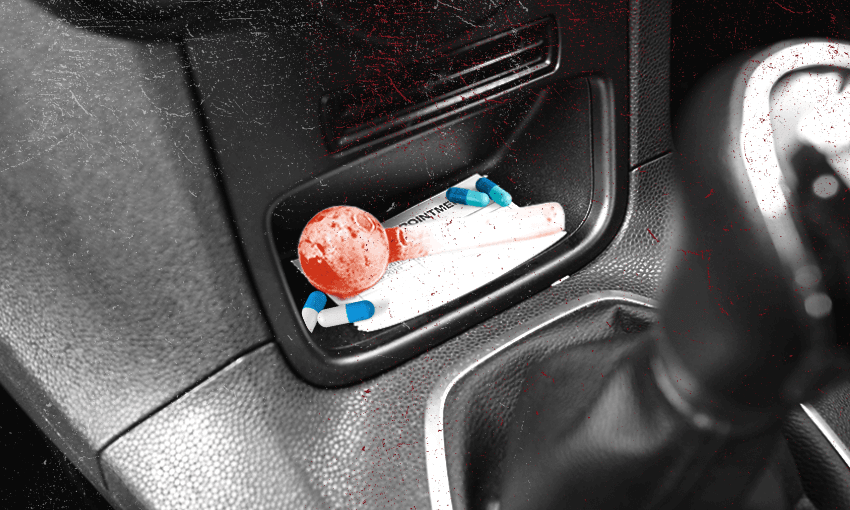It took years for seatbelts to become accepted as the life-saving devices we now know them to be. And decades for drink-driving to become socially unacceptable. So, where are we at with drug driving?
Caroline Perry has witnessed many times the pain that comes in the wake of a tragedy caused by the combination of cars and drugs. As the spokesperson for Brake New Zealand, a national road safety charity, Perry works to support families who have been bereaved by fatalities on the road. And drug driving, she says, is “a significant problem for us in New Zealand, and the consequences of driving while impaired [can be] significant”. In 2021, for example, there were 99 fatal crashes where drugs were detected in a driver’s blood. Drugs are present in nearly a third of all fatal crashes on New Zealand roads.
And in those instances, Perry says, the grief is of a particular shade. While noting that everyone she works with in this capacity processes grief in their own way, she says there is a unique edge when the cause of that grief is someone choosing to drive while under the influence of drugs or alcohol. “The fact that somebody has made that decision to get behind the wheel, causing the death of, or a life-changing injury to, somebody else – that’s a really hard thing to go through.”
Caroline Perry, spokesperson for Brake New Zealand (Images: Supplied)
The details from press reports and court proceedings related to drug-driving accidents are often harrowing and sadly similar. Quiet, everyday scenes interrupted by reckless drivers going so fast witnesses recall the whoosh of displaced air of the car speeding past. Terrible collisions. Witnesses responding to help the victim. Horrible injuries sustained, sometimes unsurvivable or life-altering. Family members deeply afflicted not only by what they saw, but what came after. Many mention a feeling of unresolvable pain, a sense that justice eludes them, even after offending drivers have been sentenced.
As levels of meth use rise throughout the country – wastewater testing has revealed a national doubling of increase in use over the past year – and the country’s cannabis consumption remains one of the highest in the world, it is those two substances Perry believes are the most likely to be dangerously inhibiting the country’s drivers. Both substances come cloaked in myths that they can actually make you a better driver – meth by putting you in a state of hyper-awareness and by banishing any thought of tiredness, cannabis by decreasing your inclination for risk-taking behaviour – but, as Perry points out, the opposite is actually true. Meth can be responsible for unpredictable, erratic behaviour and a feeling of invincibility; cannabis slows reaction times, decreases a user’s ability to concentrate, and impairs coordination.
As Perry says, every drug – there are 25, from recreational to prescription, from cocaine to zopiclone, explicitly mentioned in the legislation – has its own profile of effects, and it is incredibly important for people who use drugs to understand that each changes the way our brains work, increasing the likelihood of a crash if we were to get behind the wheel. Equally important, she says, is to understand how long you will need to wait after having taken a substance before it is safe to drive. Some effects can linger, even if it feels to the driver that they are safe to get on the road. “Any impairment is risky, because your brain is going to be functioning differently, and that poses a risk on the roads, because driving is a complex task. It’s the riskiest thing that most of us do on a regular basis,” says Perry.
She believes we are psychologically accustomed to that risk by our sheer familiarity with driving, and that we often carry an irrational, subconscious sense that merely because something terrible hasn’t happened to us yet, it won’t in future. “Actually, a car is a machine that can cause death or serious injury and it takes a lot of focus to operate,” she says. Anything capable of breaking that focus – tiredness, drink, drugs – has no place on the road. “Driving requires 100 percent of your concentration.”
The challenge for Perry – and for society at large – is to weave into that message an awareness of the effect that drugs can have on your driving, building on the public messaging that has worked in the past. She notes that it took a long time, and a lot of publicity, before seatbelts were entirely accepted as the lifesaving devices we now know them to be. Equally, drink driving, on the back of countless public-awareness campaigns, has become socially unacceptable to the vast majority of society. And while drink driving remains an enormous issue and is still a major cause of death on New Zealand roads, at least there is a continual national conversation on the subject. Perry hopes the same will start to apply to driving under the influence of drugs, and that conversations – between parents and younger drivers and, even more powerfully, between peers themselves – about the risks of drug driving begin to happen with more frequency.
After all, talking openly and honestly, she says, is the best tool we have to try and prevent drug driving tragedies.

